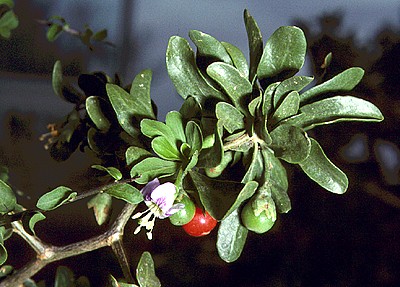 Branch with flower and fruits (Muswellbrook, NSW). Photo: J.R. Hosking © J.R. Hosking |
 Photo: M. Fagg © ANBG |
 Line drawing by L. Haegi. |

Synonymy
*Lycium ferocissimum Miers, Ann. Mag. Nat. Hist. ser. 2, 14: 187 (1854)
T: `C.B.S.—v.s. in herb Hook. Uitenhag (Harvey, n. 105)'; holo: K n.v., photo ADW.
L. macrocalyx Domin, Biblioth. Bot. 89: 590 (1929).
T: Near Jericho, Qld, Mar. 1910, Domin 8317; lecto: PR, fide L. Haegi, Austral. J. Bot. 24: 674 (1976); syn: PR.
[L. europaeum auct. non L.; F.M. Bailey, Queensland Fl. 4: 1094 (1901)]
Description
An intricately branched shrub to 4 m with long, rigid branches; lateral branches leafy, ending in a stout spine.
Leaves usually clustered, obovate to elliptic, to 40 mm long, slightly fleshy when fresh, green.
Pedicels 5–16 mm long. Calyx more or less tubular, 4–7 mm long. Corolla 10–12 mm long, pale lilac or white towards limb, the lobes lilac in centre; limb strongly reflexed. Stamens 5, exserted for 2–4 mm. Pistil c. 10 mm long. Fruiting calyx split irregularly once or twice.
Berry globose to broadly ovoid, 5–10 mm diam., dull orange-red, with 35–70 seeds. Seeds 2.5 mm long, 1.5 mm wide, dull yellow.
Distribution and ecology
Native to southern coastal region of South Africa.
Introduced to Australia as a hedge plant in late 19th century, now naturalised in all States and widespread in south-eastern Australia; also on Lord Howe Is.
A common weed in urban waste ground and agricultural and pastoral areas. In drier regions usually occurs near permanent or seasonal water supplies.
Common name
African Boxthorn
Selected specimens
W.A.: Forrest aerodrome, T.E.H. Aplin 1709 (PERTH). S.A.: Mannum, L. Haegi 599 (ADW). Qld: Dalby, Dec. 1926, W.J. Winchester (BRI). N.S.W.: near Nowra, 18 Dec. 1944, M. Tindale (NSW). Vic.: Brighton, 26 Dec. 1953, J.H. Willis (MEL).
Derivation of epithet
From ferocissimum, Latin for very fierce or spiny
Images and information on web
Many Australian government levels have produced fact sheets for this well known weed and those below represent just a few.
A fact sheet can be found on the Weeds in Australia site.
Weeds CRC: http://www.weedscrc.org.au/documents/wmg_african_boxthorn1.pdf
DEWHA: http://www.weeds.gov.au/cgi-bin/weeddetails.pl?taxon_id=19235
Qld Govt.: www.dpi.qld.gov.au/documents/Biosecurity_EnvironmentalPests/IPA-African-Boxthorn-PP8.pdf and www.nqccs.com.au/library/weeds/african_boxthorn.pdf
NSW Government: www.northwestweeds.nsw.gov.au/african_boxthorn.htm
www.wyong.nsw.gov.au/environment/Weeds_category_four_African_boxthorn.pdf
www.dpi.nsw.gov.au/__data/assets/pdf_file/0004/206176/African-boxthorn.pdf
Vic Government: www.dpi.vic.gov.au/dpi/vro/vrosite.nsf/pages/weeds_shrubs_african_boxthorn
A number of different life stage images can be seen on the CalPhotos site (as Lycium ferrocissimum).
A fact sheet on the effects of L. ferocissimum on animals can be downloaded from the Australian Weeds and Livestock pages dealing with the effects of plants on various farm animals.
Further information about L. ferocissimum can be found at the project Lycieae site which brings together species lists, keys, publications and world-wide information and images of Lycium species.
Further information about the toxic properties of this plant can be found with a search in the FDA Poisonous Plant Database
Plant status (if any)
Declared a noxious weed in most States.